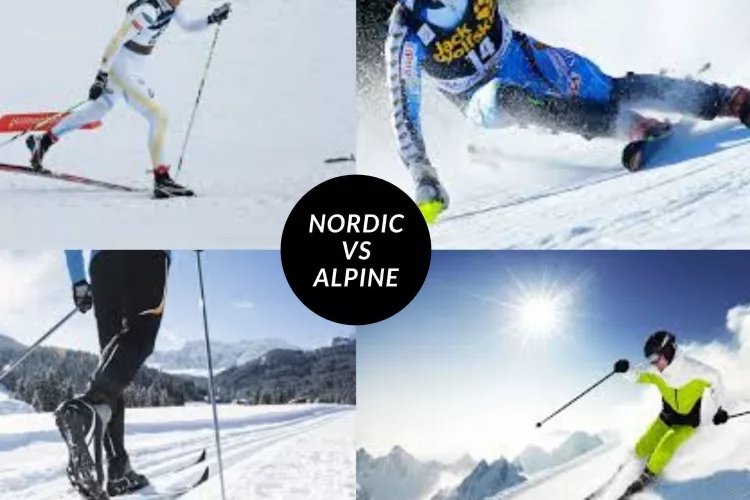Nordic Vs Alpine Skiing
by Frank V. Persall
Just like you, there are millions of people out there who love to ski. This outdoor activity can help you thrive during the winter season for someone who likes to spend time outdoors. You also get to do lots of exercises which are great for your body. The best part is that skiing is fun, little wonder it has been practiced for many centuries. Despite the evolution of this sport with time, its core elements are still the same. All you have to do is just use your skis to glide across the snow.
Contents

There are different ways to ski today. You can also make use of specialized gear and equipment depending on the style that you choose. And you can even adopt different approaches and techniques if you decide to explore the different styles. But in this article, we want to compare and contrast Alpine and Nordic skiing to determine which one is best for you.
What Is Involved?
Alpine:
Alpine skiing is popular amongst most people in the present times. Also known as downhill skiing, this is the style that is practiced at a lot of resorts around the world. Within the last century, the popularity of Alpine skiing has grown. This style has helped to birth so many other styles being performed today. Alpine skiing involves the use of poles, as well as boots and skis. However, the way that the gear is designed is very different from Nordic equipment.

Alpine skiing is usually characterized by highly powered, high-speed turns and this is the reason that these skis come with metal edges so that cutting and carving into the slow becomes very easy. Compared to Nordic skis, downhill skis are also more shaped to make turning easier and boost
performance.
You'll also notice that Alpine skiing involves the use of rigid and study ski boots which is just the opposite of cross country ski boots. What you get with Alpine ski boots is more edge control, as well as being able to maneuver no matter what the condition is. Also, Alpine skiing is different because it comes with bindings that keep your entire boots attached to the skis. This is all to ensure that you have even more control in any condition.
Nordic:
Also referred to as cross-country skiing, Nordic skiers do their stuff on rolling landscapes. The terrain is usually more gentle when compared to the downhill skiing terrain. In this form of skiing, you attach your ski boot's toe to the ski without attaching the heel. For many years, this skiing style has been practiced and the reason for its development was to aid long-distance movement through very deep snow. Although the skiing industry has evolved in terms of materials and technology over time, the basics of Nordic skiing are unchanged.

Nordic skiing is arguably the first style of skiing as other styles and techniques have their roots in Nordic history. In cross-country skiing, the pushing, skating, and grabbing through the snow are all done with long skis and poles. You'll find that this method is better than if you decided to walk or snowshoe, as skating and gliding over snow happens to be more efficient.
In modern times, just like in Alpine skiing, the setup of Nordic skiing involves the use of poles, as well as boots and skis. One thing that differentiates Nordic skiing from Alpine skiing is the nature of the ski boots used (which are usually flexible and soft, as well as lightweight and warm). Another thing about cross-country skis is that they are mostly longer and narrower, giving them a more efficient cut-through while staying above the snow. Since the terrain intended for Nordic skiing is varied and flat, Nordic skis come without an edge. Nordic skiing has two primary styles which include –
- Skate Skiing
This style of Nordic skiing involves the use of shorter skis. Kicking your skis out to the side will
drive you forward just like how it is done in ice skating. For a more efficient movement, the trail
needs to be well-prepared for skate skiing. - Classic Skiing
This is a form of Nordic skiing that involves keeping the skis parallel while kicking and gliding
forward and back. This is also referred to as the diagonal stride. The area that’s ideal for classic
skiing needs to be groomed which parallels tracks that are specially designed for your skis.
Alternatively, a terrain like a big open field or forest road which isn’t groomed can serve the
same purpose.
Alpine Vs Nordic Skiing - The Health Impact

in the United States alone, millions of people are ski enthusiasts and take part in either Nordic or Alpine skiing. So many people have found a really fun way to enjoy the winter season. But what impact do Alpine and Nordic skiing have on health?
There is more to skiing than just fun. Both cross-country and downhill skiing have benefits for your body. During the winter season, most people habitually spend their time on the couch and engage in passive activities. But skiing helps you to get outdoors and stay active. When you ski, it’s a great way of building your endurance and tolerance. Both cross-country and downhill skiing are great for your health but they improve your body differently. Here’s how:
Alpine
One benefit of Alpine skiing is that you can put in several hours at a stretch. It's also a great way to strengthen small and large muscle groups such as your hamstrings and quadriceps, as well as core and upper body. When you invest time to work on these groups of muscles, check out the different ways that it improves your overall well-being –
- More self-awareness
Alpine skiing makes you more aware of your body. This skiing style involves balance and
coordination at levels that enhance your ability to sense the position of your legs and arms and
apply better control. You will also have a heightened awareness of positional changes and little
movements. - Bone/joint strengthening
As you keep shifting your weight on different sides, you build your hip, back, and knee strength.
You'll also notice more strength in your leg bones from engaging in this kind of exercise that
involves bearing lots of weight. This can help to fight against osteoporosis while preventing joint
injuries. - Better Balance
Since Alpine skiing involves consistent movement from side-to-side, you are sure that your core
will always stay engaged. This is a great way to strengthen your muscles while building on your
agility and balance.
Nordic
You can compare this type of skiing to running because it involves the constant lifting of your skis. This type of workout is concentrated on the upper limbs, as well as your lower large muscle groups. This is much different from what happens in Alpine skiing. That is why exhaustion sets in after half an hour of activity. But the workout you get within that period gives you amazing benefits. Here they are –
- Enhanced cardiovascular health
The level of strain involved in this activity pushes your heart to its limits. This helps your heart to
become stronger and improves its efficiency while slowing down your heart rate. - Works on your large muscles
A great way to exercise your large muscle groups is through Nordic skiing. Apart from the effort
that your leg and core muscles exert, your biceps and triceps are also put to work. - Gets rid of calories
Nordic skiing is very intense and can help to get rid of excess calories. You can burn so many
calories in just one hour of Nordic skiing.
It is clear that both Alpine and Nordic skiing have lots of positive benefits for your body but through different means. However, the common advantage that you get from both activities is that they can serve as a mood booster that enhances your emotional well-being.
So, Which One Is Right For You?
Deciding what’s best for you in the Nordic Vs Alpine skiing argument simply depends on what your preferences are. If you are someone who loves the speed and adrenaline, we bet that you'll enjoy Alpine skiing more. But if your interests are more attuned to a gentle pace while discovering new mountain trails, you’ll want to try out Nordic skiing.
But who says you can’t try out both skiing styles on your next vacation?
Here’s the thing: Since Nordic skiing allows you to move at a pace that helps you enjoy scenic mountain views, you can try it out first. Then, the next day, indulge in a little bit of Alpine skiing for the thrill of speed before deciding what's best for you.
Both activities are indeed fun to engage in and every sports enthusiast could do well to try both of them out. Even if Alpine skiing seems to be the most popular, we are sure that Nordic skiing will also appeal to you once you try it out.
Related Posts:
How To Fix Skiing With Bad Knees
 |
 |
 |
 |

About Frank V. Persall
Frank is originally from the UK, but he has a passion for skiing that knows no bounds. He has made it his life's mission to visit the best ski resorts across the USA and the World. Frank loves spending time with his wife and three children on ski slopes, as they all share his love for the activity.
Thoughts on "Nordic Vs Alpine Skiing"
 |
 |
 |
 |
You can get FREE Gifts. Or latest free skiing books here.
Disable Ad block to reveal all the info. Once done, hit a button below
 |
 |
 |
 |